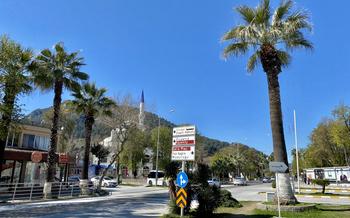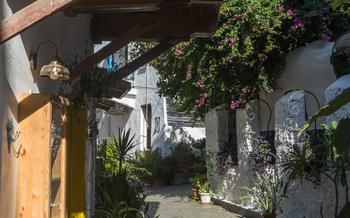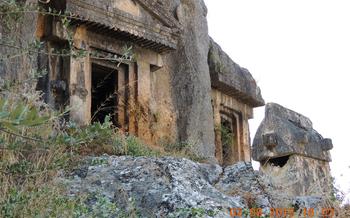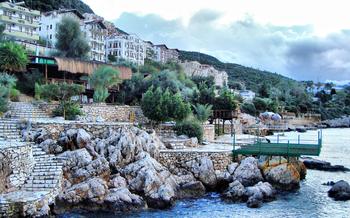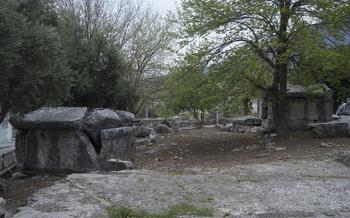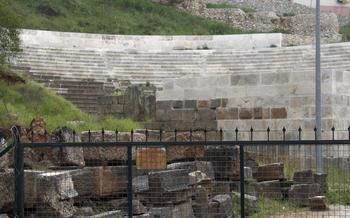
Xanthos Ancient City
- Xanthos Ancient City: An Overview
- Exploring the Ruins of Xanthos
- The Acropolis of Xanthos
- The Theater of Xanthos: A Stage for Ancient Performances
- The Stele of Xanthos
- The Necropolis of Xanthos
- The Xanthos Archaeological Museum: Unveiling Ancient Treasures
- Tips for Visiting Xanthos Ancient City
- Exploring the Surrounding Area
- Local Cuisine and Restaurants
- Accommodation Options
- Shopping and Local Handicrafts
- Cultural Events and Festivals
- Safety and Security
- Insider Tip: Hidden Gem
Xanthos Ancient City: An Overview
Xanthos, an ancient Lycian city, holds a prominent place in the annals of history. Its strategic location at the crossroads of trade routes made it a flourishing center of commerce and culture. The city's rich history spans centuries, leaving behind a treasure trove of ruins and artifacts that captivate visitors to this day.
Xanthos was founded in the 5th century BC by the Lycians, an Anatolian people known for their maritime prowess and cultural achievements. The city quickly rose to prominence, becoming one of the most important urban centers in Lycia. Its strategic location, nestled between the Taurus Mountains and the Mediterranean Sea, allowed it to control trade routes and access to natural resources.
In the 4th century BC, Xanthos fell under the rule of the Achaemenid Empire, which brought with it Persian influences that blended with the local Lycian culture. During this period, the city experienced a period of prosperity and expansion, reflected in the construction of impressive structures and monuments.
Later, Xanthos became part of the Hellenistic world under the rule of Alexander the Great and his successors. The city's strategic importance continued to attract the attention of various empires, including the Romans, who eventually conquered it in the 1st century BC. Under Roman rule, Xanthos flourished once again, becoming an important administrative center and a hub for trade and commerce.
The city's decline began in the Byzantine era, as it faced numerous challenges, including invasions, earthquakes, and the rise of Christianity. Gradually, Xanthos was abandoned, and its ruins were left to the mercy of time. Today, the ancient city stands as a testament to the rich history and cultural heritage of the Lycian civilization, inviting visitors to explore its fascinating ruins and uncover the secrets of its past.
Exploring the Ruins of Xanthos
Strolling through the ancient city of Xanthos is like taking a journey back in time. The ruins speak volumes about the rich history and architectural prowess of the Lycians. Among the most notable landmarks is the imposing acropolis, which once served as the city's fortified citadel. Its sturdy walls and well-preserved gates offer a glimpse into the defensive strategies of the Lycians.
Other architectural highlights include the Temple of Leto, with its elegant columns and intricate carvings, and the Bouleuterion, where the city's council gathered to make important decisions. The theater, with its impressive seating capacity and remarkable acoustics, is a testament to the Lycians' love for the arts and entertainment.
As you wander through the ruins, keep an eye out for the many Lycian inscriptions and carvings that adorn the buildings and monuments. These inscriptions provide valuable insights into the history, culture, and religious beliefs of the Lycians. Xanthos is a treasure trove of ancient wonders, and exploring its ruins is an unforgettable experience that will transport you back to a bygone era.
The Acropolis of Xanthos
Located on a hill overlooking the city, the Acropolis of Xanthos was the fortified center of the ancient city. The acropolis was surrounded by massive stone walls, with well-preserved fortifications and gates that provided access to the interior. The gates featured intricate carvings and inscriptions, showcasing the skill and artistry of the Lycian builders.
Within the acropolis, visitors can explore the remains of various temples and public buildings that once served important functions in the life of Xanthos. The Temple of Leto, dedicated to the Greek goddess Leto, is one of the most notable structures. Its ruins include well-preserved columns, pediments, and friezes adorned with exquisite carvings depicting mythological scenes.
Other significant buildings in the acropolis include the Bouleuterion, which served as the council chamber, and the Prytaneion, where the city's officials would gather and dine. These buildings provide valuable insights into the political and administrative systems of ancient Xanthos.
The Theater of Xanthos: A Stage for Ancient Performances
The Theater of Xanthos, an impressive monument of the ancient city, stands as a testament to the rich cultural and artistic traditions of the Lycian civilization. Situated at the foot of the acropolis, this well-preserved theater is a marvel of ancient engineering and acoustics. With a seating capacity of approximately 1,800, the theater accommodated a significant portion of the city's population, who gathered to witness performances that ranged from dramatic plays to musical concerts.
The theater's design showcases a typical Hellenistic style, featuring a circular orchestra, a raised stage, and ascending tiers of seating. The orchestra, which served as the performance space, is surrounded by a low wall and adorned with intricate reliefs depicting mythological scenes and figures. The stage, elevated above the orchestra, provided a platform for actors and musicians to engage with the audience.
The seating area, divided into several sections, accommodated spectators from different social classes and ranks. The lower tiers, closer to the stage, were reserved for prominent citizens and officials, while the upper tiers were designated for the general public. The seats, meticulously carved from local stone, feature armrests and backrests, ensuring comfort during extended performances.
The theater's acoustics are particularly noteworthy, demonstrating the advanced understanding of sound engineering possessed by the ancient Lycians. The carefully designed shape of the auditorium, coupled with the natural amphitheater-like setting, ensures that the actors' voices and musical notes carry clearly to every corner of the theater. This acoustic excellence made the Theater of Xanthos a renowned venue for dramatic and musical performances, attracting audiences from neighboring cities and beyond.
Imagining the theater bustling with life, filled with the vibrant colors of costumes and the sounds of music and applause, offers a glimpse into the rich cultural heritage of Xanthos. It is a testament to the enduring legacy of the Lycians, whose artistic achievements continue to captivate and inspire visitors to this ancient city.
The Stele of Xanthos
Historical Significance
The Stele of Xanthos, also known as the Xanthos Obelisk, stands as a testament to the rich history and cultural heritage of the Lycian civilization. Erected in the 4th century BC, this imposing monument proudly displays inscriptions in both Lycian and Greek, providing valuable insights into the lives, beliefs, and customs of the ancient Lycians. The intricate carvings and inscriptions on the stele narrate tales of battles, alliances, and significant events that shaped the course of Lycian history.
Inscriptions and Carvings
The stele, with its towering presence, features intricate carvings and inscriptions that have captivated scholars and historians for centuries. The Lycian script, a unique writing system developed by the Lycians, adorns the stele alongside Greek inscriptions, reflecting the cultural exchange and interaction between these ancient civilizations. The stele's inscriptions offer a glimpse into the political, social, and religious aspects of Lycian life, shedding light on their laws, customs, and beliefs.
The Necropolis of Xanthos
The necropolis of Xanthos is an awe-inspiring sight, showcasing the Lycians' unique burial practices and artistic prowess. Carved into the surrounding cliffs, these elaborate rock-cut tombs are a testament to their advanced engineering and craftsmanship. Each tomb is adorned with intricate facades, featuring intricate carvings, friezes, and inscriptions.
The most notable tombs include the Harpy Tomb, named after the mythical creatures depicted on its facade. The Nereid Monument, with its exquisite sculptures depicting scenes from Greek mythology, is another must-see. These tombs offer a glimpse into the lives, beliefs, and artistic traditions of the ancient Lycians.
Strolling among these ancient tombs, one cannot help but be captivated by the sheer scale and grandeur of the necropolis. It serves as a poignant reminder of the rich history and cultural heritage of this ancient civilization.
The Xanthos Archaeological Museum: Unveiling Ancient Treasures
The Xanthos Archaeological Museum is a treasure trove of artifacts and exhibits that provide a deeper insight into the rich history and culture of the ancient city. Founded in 1959, the museum houses a remarkable collection of sculptures, inscriptions, pottery, and other relics excavated from the Xanthos ruins and its surrounding areas.
The museum's collection is organized into various sections, each showcasing different aspects of Xanthos' past. One of the highlights is the Lycian Gallery, which features an array of Lycian funerary stelae and sarcophagi, adorned with intricate carvings and inscriptions that offer glimpses into the lives and beliefs of the ancient Lycian people.
Another notable section is the Sculpture Gallery, which houses an impressive collection of statues, busts, and reliefs, many of which depict Greek and Roman deities, mythological figures, and historical personalities. These works of art provide valuable insights into the artistic traditions and influences that shaped Xanthos' cultural heritage.
The museum also boasts a collection of pottery, jewelry, coins, and other everyday objects that shed light on the daily lives of the city's inhabitants. These artifacts offer a glimpse into the economic activities, trade networks, and domestic customs of ancient Xanthos.
A visit to the Xanthos Archaeological Museum is an essential complement to exploring the ancient city. It allows visitors to delve deeper into the history, culture, and artistic achievements of this remarkable civilization, bringing the past to life in a tangible and engaging way.
Tips for Visiting Xanthos Ancient City
Best time to visit:
The best time to visit Xanthos Ancient City is during the shoulder seasons (April-May and September-October) when the weather is pleasant, and the crowds are smaller. During the summer months (June-August), temperatures can be scorching, especially during the midday hours. However, if you do visit during the summer, make sure to bring plenty of water, sunscreen, and a hat to protect yourself from the sun.
Dress code and etiquette:
When visiting Xanthos Ancient City, it is important to dress respectfully, as it is a sacred and historical site. Avoid wearing revealing or offensive clothing, and be mindful of the local customs and traditions. It is also important to be respectful of the ruins and refrain from touching or climbing on them.
Guided tours:
To make the most of your visit, consider booking a guided tour. Guided tours are available in various languages and provide valuable insights into the history, culture, and significance of Xanthos Ancient City. Tours typically cover the major landmarks, monuments, and ruins, and offer a deeper understanding of the site's past.
Picnic and relaxation:
Xanthos Ancient City is surrounded by beautiful natural scenery, making it an ideal spot for a picnic lunch or a relaxing break. There are designated picnic areas within the site where you can enjoy your meal while taking in the stunning views.
Photography:
Photography is allowed within Xanthos Ancient City, and it is encouraged to capture the beauty and grandeur of the ruins. However, be respectful of other visitors and avoid using flash photography, as it can be disruptive to others.
Exploring the Surrounding Area
Beyond the ancient ruins, the region surrounding Xanthos offers a wealth of natural and historical attractions. Just a short drive away lies the stunning Patara Beach, known for its pristine sands and crystal-clear waters. Visitors can bask in the sun, swim in the refreshing sea, or explore the ancient ruins of the once-thriving port city of Patara.
For a taste of local culture, head to the lively market town of Fethiye, where you can browse traditional bazaars, sample delicious Turkish cuisine, and immerse yourself in the vibrant atmosphere. Don't miss the opportunity to visit the Fethiye Museum, which houses a collection of artifacts from the region's rich past.
Nature enthusiasts can embark on a scenic hike through the Saklıkent Gorge, a breathtaking natural wonder with towering canyon walls and crystal-clear waters. The gorge offers a unique opportunity to explore the beauty of the Turkish countryside and cool off on a hot summer day.
To delve deeper into the region's history, visit the nearby ancient city of Tlos, with its well-preserved ruins, including an impressive acropolis, theater, and temple. Tlos offers a glimpse into the lives of the ancient Lycians and is a must-see for history buffs.
Transportation options in the region are varied and convenient. Local buses and minibuses provide affordable and reliable connections between Xanthos and nearby towns and attractions. For a more flexible and personalized experience, consider renting a car, which allows you to explore the surrounding area at your own pace.
Local Cuisine and Restaurants
Authentic Flavors of Xanthos: A Culinary Journey
Xanthos offers a tantalizing culinary scene that blends traditional Turkish flavors with Mediterranean influences. Indulge in the local delicacies, such as pide, a boat-shaped flatbread filled with savory ingredients like minced lamb, cheese, and vegetables. Savor the succulent meze, a selection of small dishes served as appetizers, showcasing a variety of dips, salads, and grilled meats.
Don't miss the Xanthian kebabs, tender chunks of lamb or chicken grilled to perfection and seasoned with aromatic herbs. For a taste of the sea, try the freshly caught fish, grilled or fried, served with a tangy lemon sauce. Vegetarians will delight in the stuffed eggplant, a flavorful dish made with grilled eggplant filled with rice, vegetables, and herbs.
When it comes to restaurants, Xanthos offers a range of options to suit every palate and budget. For a memorable dining experience, head to one of the traditional Turkish restaurants in the old town. Enjoy the warm ambiance and savor authentic dishes prepared with fresh, local ingredients.
For a more casual meal, try one of the many cafes or snack bars scattered throughout the city. These eateries offer a variety of quick bites, such as simits (Turkish bagels), gözleme (savory pancakes), and pide.
No matter where you choose to dine, be sure to sample the local wines, produced in the nearby vineyards. The region is known for its rich viticulture, and the wines offer a unique blend of Mediterranean flavors.
Insider Tip: For a true taste of Xanthian cuisine, visit the local market and buy fresh produce, cheese, and olives. Prepare a picnic lunch and enjoy it amidst the ancient ruins, surrounded by history and natural beauty.
Accommodation Options
Hotels and guesthouses: - Ölüdeniz offers a range of accommodation options to suit different budgets and preferences. - For a luxurious stay, consider the beachfront resorts with private pools and stunning sea views. - Mid-range hotels and guesthouses provide comfortable rooms with essential amenities. - Many hotels offer traditional Turkish breakfast with local delicacies.
Camping and budget options: - For budget travelers, camping is a popular option. - Several campsites are located near the beach, offering basic facilities and a chance to experience nature. - Hostels and guesthouses with dormitory-style rooms are also available for budget-conscious travelers.
Insider Tip: - Book your accommodation in advance, especially during peak season, to avoid disappointment. - Consider staying in nearby towns like Fethiye or Hisarönü for more affordable options. - Look for hotels or guesthouses with rooftop terraces for panoramic views of Ölüdeniz and the surrounding mountains.
Shopping and Local Handicrafts
When visiting Xanthos, immerse yourself in the vibrant local culture by exploring the bustling markets and bazaars. These vibrant marketplaces offer a treasure trove of unique souvenirs and handmade crafts that reflect the rich heritage of the region. From intricate carpets and textiles to hand-painted ceramics and jewelry, there's something for every taste and budget. Haggling is expected and part of the shopping experience, so don't be afraid to negotiate a good price.
Must-buy souvenirs include traditional Turkish carpets, known for their vibrant colors and intricate designs. Hand-painted ceramics and pottery, showcasing intricate patterns and motifs, are also popular choices. For those seeking unique jewelry, Xanthos offers a variety of handmade pieces crafted from silver, gold, and semi-precious stones.
To experience the authentic ambiance of local markets, visit the weekly farmers' market held in the town square. Here, you'll find fresh produce, local delicacies, and handmade goods from the surrounding villages. Don't miss the opportunity to sample traditional Turkish delights such as gözleme (savory filled flatbread) and freshly squeezed pomegranate juice.
Cultural Events and Festivals
Xanthos Ancient City comes alive during cultural events and festivals that showcase the region's rich heritage and traditions. The annual Xanthos Festival, held in summer, is a vibrant celebration featuring traditional music, dance, theater performances, and local crafts. Visitors can immerse themselves in the lively atmosphere, savor delicious Turkish cuisine, and witness the vibrant local culture firsthand.
Other notable events include the Xanthos Ancient Music Festival, which features concerts and performances by renowned musicians in the ancient theater, and the Xanthos International Sculpture Symposium, where artists from around the world gather to create and exhibit their works amidst the ruins, providing a unique blend of art and history.
Participating in these events and festivals offers a wonderful opportunity to connect with the local community, learn about their customs and traditions, and create lasting memories of your visit to Xanthos Ancient City.
Safety and Security
General safety tips
Like any other tourist destination, Xanthos Ancient City is generally safe for visitors. However, it's essential to take basic precautions to ensure a safe and enjoyable experience. Here are some general safety tips:
- Be aware of your surroundings and avoid walking alone in isolated areas, especially at night.
- Keep valuables such as passports, money, and credit cards secure. Consider using a money belt or other security measures.
- Respect local customs and traditions. Dress modestly and behave respectfully when visiting religious or cultural sites.
- Drink plenty of water to stay hydrated, especially during the hot summer months.
- Protect yourself from the sun by wearing sunscreen, sunglasses, and a hat.
- Be mindful of potential scams or pickpocketing, particularly in crowded areas.
- If you are traveling alone, consider joining a guided tour or group excursion for added safety.
Emergency contacts
In case of an emergency, here are some important contact numbers:
- Police: 155
- Ambulance: 112
- Fire Department: 110
- Tourist Information: +90 (252) 845 20 01
- U.S. Embassy in Ankara: +90 (312) 455 55 55
Remember, it's always advisable to exercise caution and common sense when traveling to any new destination. By following these safety tips, you can help ensure a safe and enjoyable visit to Xanthos Ancient City.
Insider Tip: Hidden Gem
Beyond the main attractions of Xanthos Ancient City, there lies a hidden gem waiting to be discovered. Follow the path leading away from the theater and delve into the serene tranquility of the Lycian Way. This enchanting trail meanders through picturesque landscapes, offering breathtaking views of the ancient city and the surrounding mountains. As you amble along the path, you'll encounter secluded coves, tranquil beaches, and hidden ruins that tell tales of Xanthos' rich past. Take a moment to pause and soak in the tranquility of this unspoiled paradise, where nature and history converge in perfect harmony.
